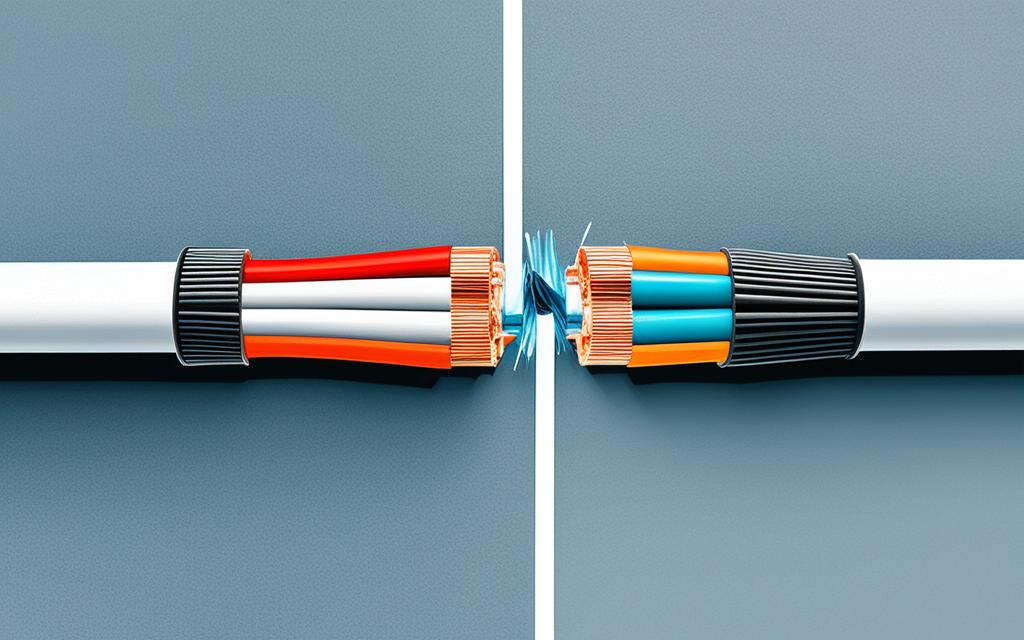In today’s digital age, communication networks play a crucial role in facilitating seamless data transfer. Two commonly used types of cables, optical fiber and copper cabling, have emerged as the go-to options for businesses around the world. To make an informed decision about the best choice for your company’s communication infrastructure, it’s essential to understand the differences between these two options. In this article, we will provide a comparative analysis of optical fiber and copper cabling in terms of security, bandwidth and distance, cost, flexibility and size, immunity, and safety.
During our analysis, we will delve into the various aspects of both optical fiber and copper cabling, examining their strengths and weaknesses. Our aim is to simplify the decision-making process for businesses seeking reliable and high-performance communication systems.
Security and Bandwidth
Fiber optic cables provide a higher level of security compared to copper cables. They are made of glass, which does not radiate signals and is extremely difficult to tap or intercept. This makes fiber optic cables ideal for businesses and organizations that prioritize data security and confidentiality.
In terms of bandwidth, fiber optics offer a significant advantage over copper cables. Fiber optic cables have a much higher capacity and can transmit data at speeds of up to 10 gigabits per second (Gbps). This high bandwidth allows for faster and more efficient data transmission, making fiber optics suitable for applications that require large amounts of data to be transferred quickly.
“Fiber optic cables provide unparalleled security and bandwidth capabilities, making them the preferred choice for businesses that value data protection and high-speed communication.”
On the other hand, copper cables have limited bandwidth compared to fiber optics. They are not suitable for transmitting large amounts of data over long distances. Copper cables are more commonly used for applications that require lower bandwidth, such as telephone lines or residential internet connections.
Below is a comparison between fiber optic and copper cables in terms of security and bandwidth:
| Cable Type | Security | Bandwidth |
|---|---|---|
| Fiber Optic | High | High (up to 10 Gbps) |
| Copper | Lower | Limited |
Benefits of Fiber Optic Cables:
- Enhanced security and resistance to hacking or interception
- High bandwidth capacity for fast and efficient data transmission
- Reliable performance over long distances
Durability and Immunity
When it comes to durability and immunity, fiber optic cables outshine copper cables. Fiber optics are made of glass or plastic, making them lighter and thinner in comparison to their copper counterparts. This characteristic enhances their durability, making them less susceptible to damage during installation.
Moreover, fiber optic cables exhibit immunity to electromagnetic interference, ensuring reliable performance even in noisy environments. This immunity protects the data being transmitted and reduces the chances of errors or disruptions.
In contrast, copper cables can experience signal degradation and are vulnerable to interference. This can result in data loss or errors, compromising the overall reliability of the communication system.
Overall, fiber optic cables demonstrate superior durability and immunity compared to copper cables, making them a more reliable choice for a wide range of applications.
Benefits of Fiber Optic Cables:
- Lighter and thinner compared to copper cables
- Less susceptible to damage during installation
- Immune to electromagnetic interference
- Enhanced data transmission reliability and security
Disadvantages of Copper Cables:
- Signal degradation
- Proneness to interference
- Potential for data loss or errors
When it comes to building a robust and reliable communication network, the durability and immunity offered by fiber optic cables make them the preferred choice over copper cables. Their ability to withstand harsh conditions and avoid interference ensures seamless data transmission and a secure information exchange.

Cost and Compatibility
When it comes to choosing between fiber optic and copper cables for your communication network, cost and compatibility are key factors to consider. While fiber optic cables may have a higher upfront cost compared to copper cables, their long-term cost-effectiveness and performance make them a worthwhile investment.
Fiber optic cables offer higher performance and reliability compared to copper cables. With fiber optics, you can achieve faster data transmission rates and larger bandwidth, allowing for seamless communication and the ability to handle increasing data demands. This can have a significant impact on your business’s productivity and efficiency.
Another advantage of fiber optic cables is their compatibility with modern networking technologies. They are designed to support high-speed data transmission and are compatible with various network protocols, making them future-proof. Fiber optics can easily integrate into existing network infrastructure, enabling smooth upgrades and expansions.
On the other hand, copper cables are known for their cost-effectiveness and wide availability. They have been used for decades and are compatible with most existing infrastructure. Copper cables are more affordable to install initially, which can be an attractive option for businesses with budget constraints.
| Fiber Optic Cables | Copper Cables | |
|---|---|---|
| Cost | Higher upfront cost | Lower installation cost |
| Compatibility | Compatible with modern technologies and protocols | Compatible with most existing infrastructure |
Despite the higher upfront cost, fiber optic cables offer long-term benefits in terms of performance, reliability, and future compatibility. They are ideal for businesses that require high-speed and reliable data transmission. On the other hand, copper cables are a more cost-effective option for businesses on a tight budget or those looking to upgrade their existing infrastructure without significant changes.
Investing in fiber optic cables allows businesses to future-proof their communication networks and enjoy the benefits of faster, more reliable data transmission. However, it’s essential to evaluate your specific needs and budget constraints before making a decision.

Conclusion
In conclusion, when comparing fiber optic cables to copper cables, it is evident that fiber optics offer significant advantages. They excel in terms of security, as their construction makes them difficult to tap into or intercept. Moreover, fiber optic cables provide much higher bandwidth capacities, allowing for faster data transmission speeds of up to 10 gigabits per second.
Additionally, fiber optic cables demonstrate greater durability, as they are less prone to damage during installation and are immune to electromagnetic interference. This makes them highly reliable in noisy environments where copper cables may experience signal degradation and interference-related data loss.
Although fiber optic cables may have a higher upfront cost, their superior performance and long-term cost-effectiveness make them the preferred choice for businesses with high-speed and reliable data transmission needs. However, copper cables still have their advantages, including lower costs and compatibility with existing infrastructure, making them a viable option for businesses with budget constraints.
Ultimately, the decision between fiber optic and copper cables will depend on the specific needs and requirements of the business. While fiber optics offer superior security, bandwidth, durability, and immunity against interference, copper cables can still be a suitable option for businesses operating within tight budget constraints or that require compatibility with their existing infrastructure.
FAQ
What is the difference between fiber optic and copper cables?
Fiber optic cables are made of glass or plastic and offer higher security, larger bandwidth, and immunity to interference. On the other hand, copper cables are made of metal and have limited bandwidth and susceptibility to interference.
Are fiber optic cables more secure than copper cables?
Yes, fiber optic cables provide higher security as they are difficult to tap or intercept. Their signals do not radiate and they are extremely difficult to hack into.
What is the bandwidth capacity of fiber optic cables?
Fiber optic cables have a much higher capacity compared to copper cables and can transmit data at speeds of up to 10 gigabits per second.
Are fiber optic cables more durable than copper cables?
Yes, fiber optic cables are more durable and less susceptible to damage during installation. They are made of glass or plastic, which makes them lighter and thinner.
Are fiber optic cables immune to electromagnetic interference?
Yes, fiber optic cables are immune to electromagnetic interference, making them more reliable in noisy environments.
What is the cost difference between fiber optic and copper cables?
Fiber optic cables are generally more expensive upfront compared to copper cables. However, their long-term cost-effectiveness and performance often outweigh the initial cost.
Are copper cables compatible with existing infrastructure?
Yes, copper cables are compatible with most existing infrastructure, making them an easier upgrade for older networks.
Which type of cable is better for high-speed and reliable data transmission?
Fiber optic cables are the preferred choice for businesses with high-speed and reliable data transmission needs due to their higher data transmission rates, larger bandwidth, and immunity to interference.
What should be considered when choosing between fiber optic and copper cables?
The choice between fiber optic and copper cables depends on the specific needs and requirements of the business. Factors such as security, bandwidth, durability, cost, and compatibility should be taken into consideration.



















